Moving forward with alternative test methods
By Robin Mackar
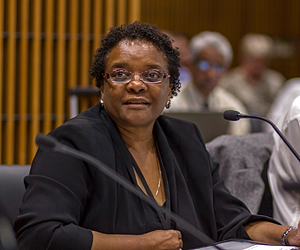
Attending her last meeting of SACATM before her term expires, Gwendolyn McCormick, D.V.M., of Boehringer Ingelheim Pharmaceuticals Inc. provided input on how ICCVAM can better communicate its progress. (Photo courtesy of Michael Garske)
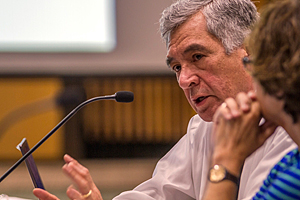
SACATM member Ochoa called for committee members to play a more active role in advising and assisting ICCVAM throughout the year. (Photo courtesy of Michael Garske)
Reflecting on past achievements, moving forward, and establishing good metrics were some of the key themes that emerged during the annual meeting of the Scientific Advisory Committee on Alternative Toxicological Methods (SACATM) (http://ntp.niehs.nih.gov/index.cfm?objectid=720165EC-BDB7-CEBA-F517D1DEE4D7D129) Sept. 5-6 at NIEHS.
“ICCVAM has tripled progress in bringing alternative methods forward in the past five years,” said Rear Adm. William Stokes, D.V.M., as he provided the advisory committee with an update on the efforts of the 15-member Interagency Coordinating Committee on the Validation of Alternative Methods (ICCVAM), (http://iccvam.niehs.nih.gov/) which his office, the NTP Interagency Center for the Evaluation of Alternative Toxicological Methods (NICEATM), (http://iccvam.niehs.nih.gov/about/about_NICEATM.htm) supports. “We now have 58 alternative test methods that have been adopted and available for use, with 36 of those being in vitro tests that do not require animals.”
ICCVAM successes
Stokes and other ICCVAM representatives elaborated on key accomplishments throughout the meeting, including progress in bringing 26 alternative methods forward for five of the six most commonly used tests to protect human health. If used, Stokes said, these tests could reduce animal use by 50 percent or more. ICCVAM has also contributed to the 14 alternative methods available for reducing and refining animal use for biologics and vaccine safety testing.
NTP associate director John Bucher, Ph.D., cited the maturation of the program over the years, during his welcoming remarks. He highlighted the creation of the International Cooperation on Alternative Test Methods. (http://iccvam.niehs.nih.gov/about/icatm.htm) as an example of what can happen when agencies and countries work together to integrate and harmonize approaches. “The result is a much more efficient process for the acceptance of alternative methods across the globe,” Bucher said. Representatives from the Republic of Korea, Japan, Canada, and the European Union were on hand at the meeting to present updates on their organizations’ efforts.
Warren Casey, Ph.D., deputy director of NICEATM, also presented new findings on a method recently recommended by ICCVAM, LUMI-CELL®, that has been specifically adapted for high-throughput or robotic toxicology testing by the National Center for Advancing Translational Sciences (NCATS). This method uses a human cell line, BG1, to identify potential endocrine disruptors without using animals. The NICEATM preliminary evaluation found that the high-throughput assay was as accurate as the manual one currently being used, and could test many substances, at different doses, in a short period of time. Casey noted that the assay was developed by an NIEHS grantee supported, in part, through the Superfund Research Program (see text box).
Other Federal efforts
Staff from NIEHS, NIH, and EPA also presented some interesting talks, as they highlighted new research areas that might be incorporated into ICCVAM’s new strategic planning efforts. Margaret Sutherland, Ph.D., of NIH, spoke about the use of the NIH Common Fund to develop 3-D tissue models to help predict drug safety; NIEHS program administrator Daniel Shaughnessy, Ph.D., highlighted projects funded by NIEHS through the Small Business Innovation Research program; (http://www.sbir.gov/) and Mary Manibusan, of the EPA, provided an update on the Endocrine Disruptor Screening Program for the 21st Century.
ICCVAM Vice-chair Joanna Matheson, Ph.D., of the U.S. Consumer Product Safety Commission, followed up by describing the four key strategic opportunities and the ongoing transformation of safety testing presented in the NICEATM-ICCVAM five-year plan.
Need for metrics
SACATM members, including Chair Steven Niemi, D.V.M., from Massachusetts General Hospital; Steven Hansen, D.V.M., from the American Society for the Prevention of Cruelty to Animals; Ricardo Ochoa, D.V.M., Ph.D., from Pre-Clinical Safety Inc.; and others, called for more metrics and quantifiable goals to determine the real impact that ICCVAM is making. “We need to start counting our accomplishments in measurable ways, as soon as possible,” Niemi said. He and others requested that ICCVAM find ways to determine baseline use of animals in safety testing and research so, a year from now, they can determine the progress made. They also called for regulatory agencies to start actively promoting the alternative methods that ICCVAM has already brought forward.
(Robin Mackar is the news director in the NIEHS Office of Communications and Public Liaison.)
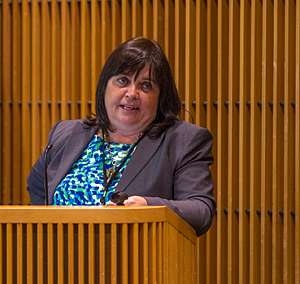
NIH’s Sutherland succinctly described an interesting project to develop microchips that can behave like human organs to help predict drug safety. The NIH Common Fund’s Regulatory Science program is a partnership of NIH, the U.S. Food and Drug Administration, and the Defense Advanced Research Projects Agency, designed to advance the field of regulatory science. (Photo courtesy of Michael Garske)
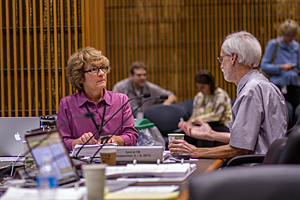
Lori White, Ph.D., left, serves as the NTP Designated Federal Officer for SACTAM meetings. She and Bucher discussed how the meeting was proceeding, during a break. White was publicly commended by Joy Cavagnaro, Ph.D., of Access BIO, during Cavagnaro’s presentation as chair of the Implementation Working Group, which looked into how ICCVAM methods are being implemented at agencies and research organizations. (Photo courtesy of Michael Garske)

Stokes noted the many achievements of ICCVAM over the past 15 years, during the SACATM meeting. (Photo courtesy of Michael Garske)

SACATM chair Niemi listened closely to all the discussions that occurred at the annual meeting. He and others called for more metrics to evaluate ICCVAM’s progress in reducing, refining, and replacing animals in chemical and product safety testing. (Photo courtesy of Michael Garske)
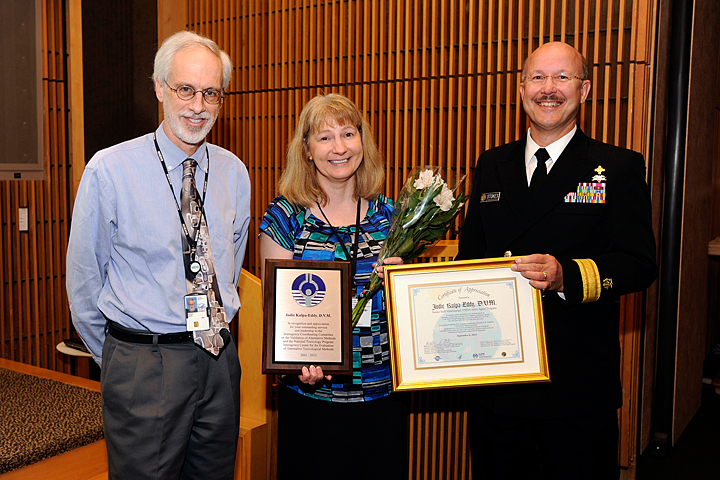
Bucher and Stokes surprised ICCVAM Chair Jodie Kulpa-Eddy, D.V.M., of the U.S. Department of Agriculture (USDA), with a plaque, certificates of appreciation, and flowers for her exceptional work with ICCVAM over the years. Kulpa-Eddy is ending her tenure on ICCVAM and will be taking on new responsibilities at USDA. (Photo courtesy of Michael Garske)
"Former postdoc lands first ..." - previous story ![]()
![]() next story - "Woychik addresses environmental epidemiologists ..."
next story - "Woychik addresses environmental epidemiologists ..."
October 2012 Cover Page


